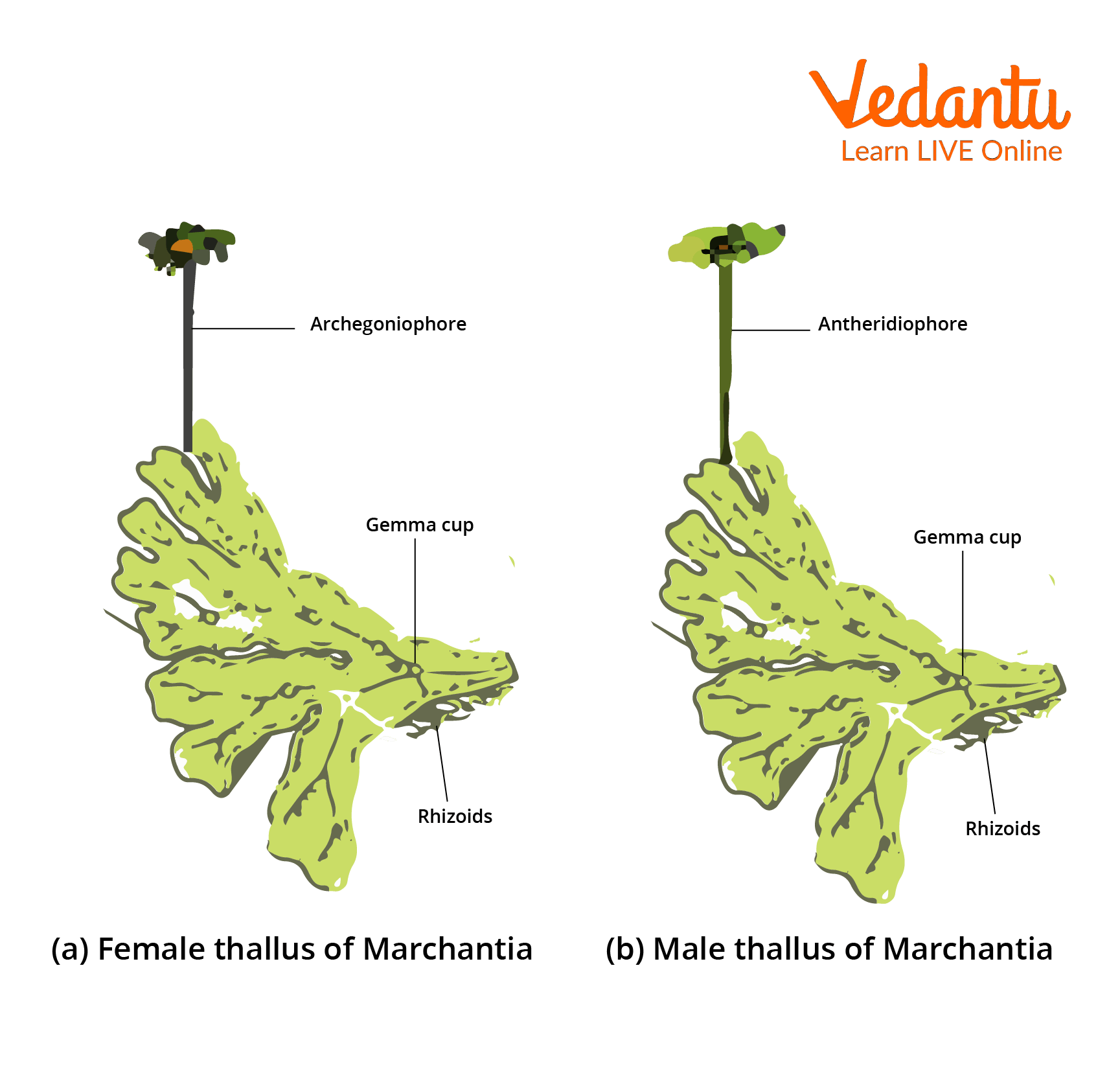How Do Riccia and Marchantia Differ in Life Cycle and Anatomy?
Riccia and Marchantia belong to the family that lies under the phylum Bryophyta. The species under the phylum Bryophyta are known as bryophytes. They are small and non-vascular and are found in moist habitats. Plants from this phylum do not reproduce sexually through flowers and seeds; rather, they reproduce through asexual means like spores. They follow the gametophyte stage and are dominant in their life cycle. Some of the common examples are mosses and liverworts.
We will discuss everything about Riccia and Marchantia in this article, along with some FAQs. This topic is full of facts and should be memorised and revised frequently. This topic is also a very important part of the chapter ‘Plant Kingdom.’ Understanding this topic would also help understand the other parts of this chapter.
Riccia
Riccia is a genus of liverworts that belongs to the family Marchantia and the order Marchantiale. Plants of this genus do not consist of vascular bundles and are commonly found in moist places or habitats. The plant body is not differentiated into roots, stems, and leaves. The plants have a rosette-like structure. The Riccia plant consists of both male and female reproductive parts in the same plant. They show both sexual and asexual modes of reproduction. They reproduce asexually through spores and fragmentation.
The Riccia Life Cycle alternates between gametophytic and sporophytic generations. As the gametophytic generation dominates, it comprises the main plant body. The Riccia sporophyte comprises the formation of the zygote from fused gametes.

Riccia Diagram
Marchantia
Marchantia is also a genus of liverworts that belongs to the family Marchantia and order Marchantiale. They are known to consist of gemma cups, which help the plant in asexual reproduction. These plants are also known to consist of a barrel-shaped pore on the top surface of their leaves. They are found in moist and shady areas, and reproduction in Marchantia is both sexually and asexually.
The Marchantia Life Cycle is haplodiplontic. Here, the gametophyte is the dominant phase, and the Marchantia sporophyte phase is dependent on the gametophyte phase for nourishment.

Marchantia Diagram
Similarities Between Riccia and Marchantia
The similarities are as follows:
Riccia and Marchantia both belong to the kingdom Plantae and both are bryophytes.
They are a genus of liverworts.
They are non-vascular plants; they do not consist of vascular bundles.
They both belong to the family Marchantia and the order Marchantiale.
They both have a haplodiplontic life cycle, with the gametophyte phase as the dominant phase.
They reproduce both sexually and asexually.
They have a prostrate and dichotomously branched thallus.
Their plant bodies are not differentiated into stems, roots, and leaves.
In both plants, fertilisation of the gametes gives rise to a zygote which forms the sporophyte stage of the plant.
Difference Between Riccia and Marchantia
Conclusion
Riccia and Marchantia both are a genus of liverworts. They share many similarities but are studied widely due to their differences. Their main difference lies in the structure of their thallus. They both have a haplodiplontic life cycle with gametophyte as the dominant phase, nourishing the sporophyte phase.
This article mentions the major difference and similarities between Riccia and Marchantia. This is an important topic for Class 11. The students should also go through the chapter ‘Plant Kingdom’ to understand the concepts clearly. However, this article is sufficient for understanding the given topic.


FAQs on Riccia vs Marchantia: Clear Differences, Structures & Functions
1. What is the main difference between Riccia and Marchantia?
The main difference lies in their complexity. Marchantia is considered more advanced than Riccia. For example, the thallus (plant body) of Marchantia is more internally differentiated with distinct air chambers and pores, and its sporophyte is complex, having a foot, seta, and capsule. In contrast, Riccia has a much simpler thallus and sporophyte structure.
2. How does the internal structure of the thallus differ in Riccia and Marchantia?
The thallus in both are dorsiventral, but their internal structures have key differences:
- Marchantia: The thallus is clearly divided into an upper photosynthetic region with well-defined air chambers and a lower storage region. Each air chamber opens to the outside through a barrel-shaped pore.
- Riccia: The thallus is much simpler. While it has a photosynthetic and storage zone, the air chambers are not as well-defined and are more like narrow vertical canals without specialised pores.
3. What are the key differences in the reproductive structures of Riccia and Marchantia?
Their reproductive structures show a clear difference in organisation:
- In Marchantia, the sex organs (antheridia and archegonia) are borne on specialised, stalked structures called antheridiophores and archegoniophores. It also reproduces asexually using gemma cups.
- In Riccia, the sex organs are embedded within the thallus along a dorsal groove and are not on specialised stalks. It lacks gemma cups for asexual reproduction.
4. Why is the sporophyte in Marchantia considered more advanced than in Riccia?
The sporophyte in Marchantia is considered more advanced because it is more differentiated. It is divided into three distinct parts: a foot (for anchoring and absorption), a seta (a stalk that helps in spore dispersal), and a capsule (where spores are produced). The sporophyte in Riccia is much simpler and consists almost entirely of a capsule, lacking a distinct foot and seta.
5. Are Riccia and Marchantia both liverworts?
Yes, both Riccia and Marchantia are types of liverworts and belong to the Class Hepaticopsida within Bryophytes. However, they belong to different orders (Marchantiales and Sphaerocarpales for many Riccia species), which accounts for their significant structural differences despite both being liverworts.
6. How does the mechanism for spore dispersal differ between the two?
In Marchantia, the stalk (seta) of the sporophyte elongates, pushing the capsule out. The capsule then splits open to release spores, which are actively dispersed with the help of elaters. In Riccia, there is no active dispersal mechanism. The spores are simply released when the surrounding thallus tissue decays and disintegrates.










